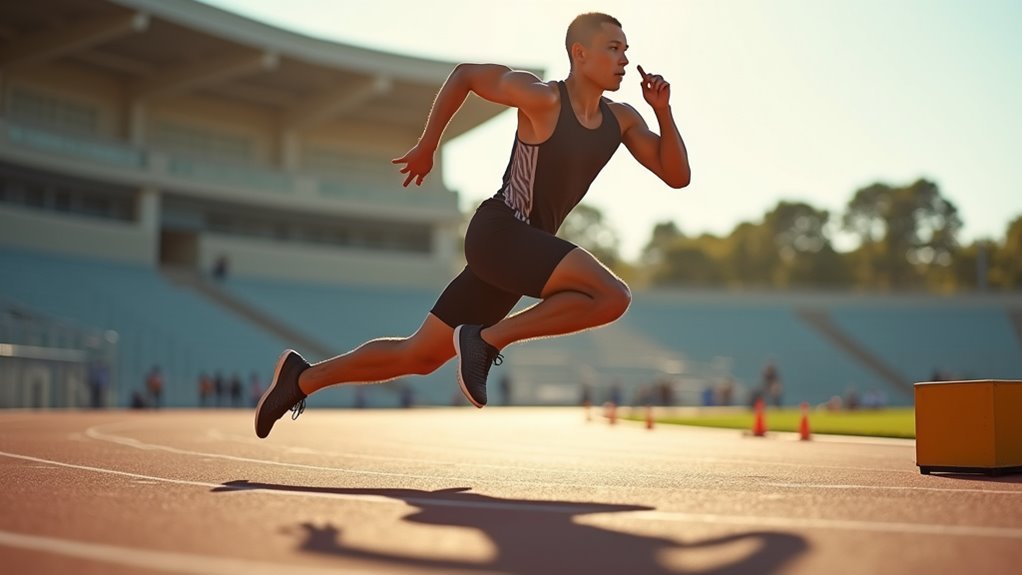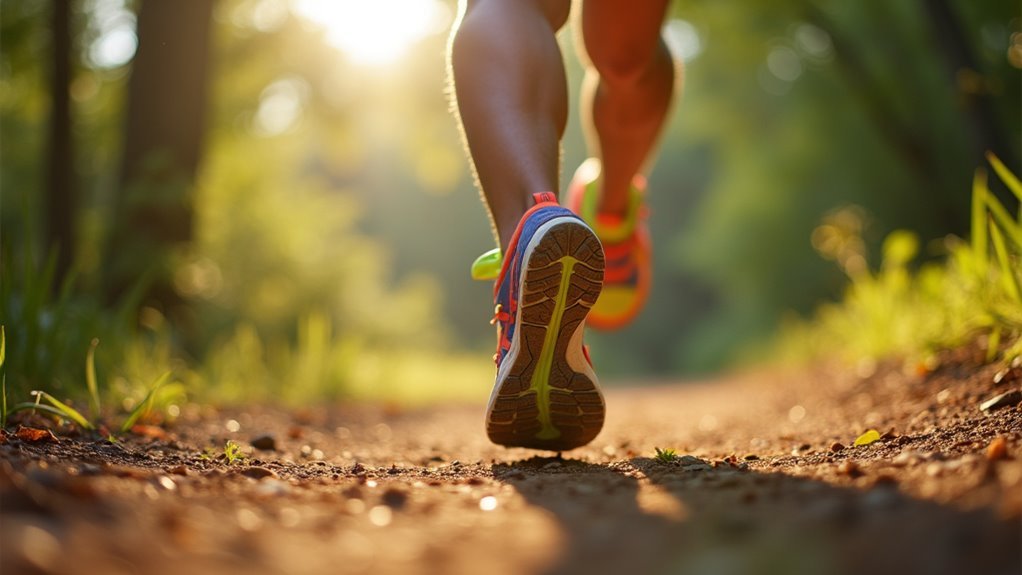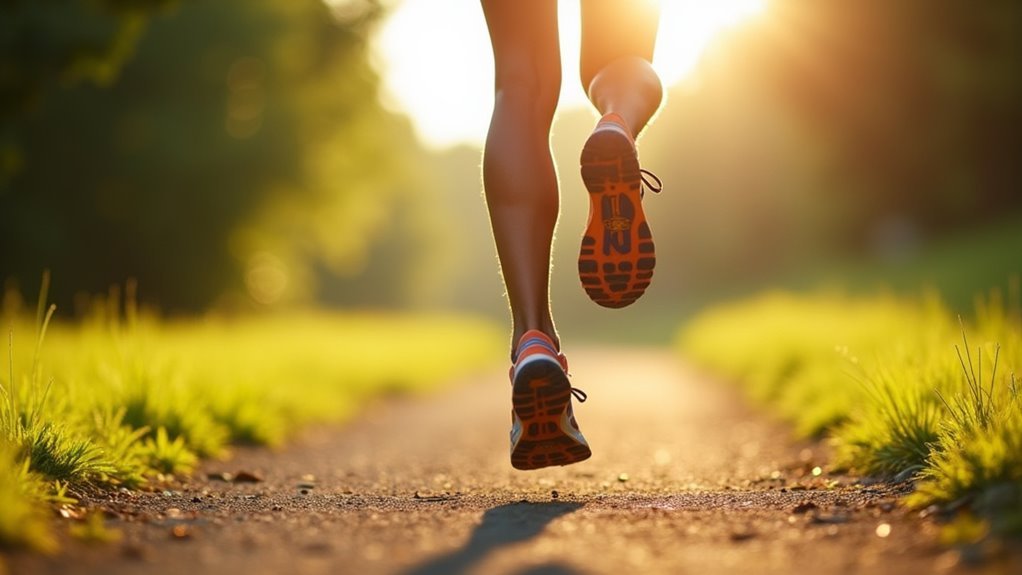You’ll reduce your ground contact time by incorporating plyometric training with sub-250 millisecond contacts, optimizing your foot strike to land midfoot under your center of gravity, and increasing cadence above 160 steps per minute. Choose lightweight shoes under 195 grams, strengthen your core and hips for stability, maintain efficient arm swing with 90-degree elbow angles, and develop leg stiffness through explosive drills. These techniques will transform your running efficiency and help you discover advanced methods for maximizing your stride power.
Incorporate Plyometric and Speed Training for Explosive Power

While traditional distance running builds endurance, plyometric and speed training develops the explosive power you need to minimize ground contact time.
Target the amortization phase with fast plyometric movements that keep ground contact under 250 milliseconds, mirroring sprint mechanics. Elite athletes achieve 80-90 ms ground contacts while producing forces three to four times their body weight.
Elite runners minimize ground contact to 80-90 milliseconds while generating forces up to four times their body weight.
Focus on quickness off the ground rather than maximal height or distance. Start with fewer repetitions and progress gradually, building up to 20 ground contacts per exercise. Quality movements should be prioritized over rushing through repetitions to ensure proper form and maximum training benefit.
Combine this with speed work like 6 x 60m sprints and hill runs to develop stride power while reducing injury risk.
Prioritize these explosive sessions before endurance work for maximum neuromuscular benefits.
Optimize Foot Strike Position and Biomechanical Form
Your foot strike position directly impacts how long you stay connected to the ground with each step.
When you land with your foot directly under your center of gravity rather than out in front, you’ll naturally reduce contact time and avoid the braking effect of overstriding.
Focus on where your foot hits the ground and how your body’s positioned over it—these small adjustments create significant improvements in your running efficiency. Forefoot strikers demonstrate a plantar-flexed ankle position at initial contact, which contributes to their distinct biomechanical pattern compared to rearfoot strikers.
Foot Strike Positioning
The position where your foot strikes the ground fundamentally determines how efficiently you’ll move through each running stride and how quickly you can shift from landing to takeoff. Your foot strike placement directly affects ground contact time, with proper positioning enabling faster changes and reduced braking forces.
Focus on these key positioning strategies:
- Land under your hips – Position your feet close to underneath your body rather than out in front.
- Aim for midfoot contact – Strike with your midfoot to balance efficiency and impact absorption.
- Maintain slight forward lean – Keep your body positioned over your feet during contact.
- Minimize overstriding – Avoid reaching too far forward with each step.
- Practice gradual changes – Slowly adapt your strike pattern to prevent injury while building efficiency.
While heel strikes are the most common pattern among recreational runners, they often create increased impact forces that extend ground contact time. Implementing shorter, quicker strides can help improve your overall cadence and reduce the time spent in contact with the ground during each step.
Center of Gravity
Running efficiently requires maintaining ideal center of gravity alignment throughout each stride cycle. Your center of gravity directly impacts ground contact time by influencing how your body interacts with the ground during each footfall.
Lower your center of gravity by increasing hip and knee flexion during your stride. This positioning improves stability and reduces the time your foot spends on the ground. Maintain a slight forward trunk lean with proper pelvic tilt to align your center of gravity for maximum forward acceleration.
Focus on consistent muscle activation around your joints to keep your center of gravity stable throughout your running motion. Avoid excessive vertical oscillation by adjusting your stride length and cadence.
When your center of gravity remains aligned with your body’s center of mass, you’ll minimize compensatory motions that increase ground contact time and reduce running efficiency. Proper foot contact should occur on the outside edge to optimize elastic energy storage and minimize braking forces that extend ground contact time.
Overstriding Prevention Techniques
Overstriding disrupts your center of gravity alignment and dramatically increases ground contact time with each footfall.
When you land with your foot too far ahead of your body, you’re creating unnecessary braking forces that slow you down and stress your joints. This inefficient landing pattern places excessive strain on your hips, knees, and ankles with each step.
To prevent overstriding and optimize your running efficiency:
- Increase your cadence to over 160 steps per minute, promoting shorter, quicker steps
- Focus on foot strike position by landing closer to your center of mass with minimal shin angle
- Strengthen core and lower limb muscles to maintain proper form throughout your run
- Practice midfoot or forefoot striking to reduce impact forces and ground contact time
- Use video analysis to identify and correct overstriding patterns in real-time
These techniques will dramatically improve your running economy.
Increase Your Running Cadence With Targeted Drills
While proper running form naturally contributes to faster cadence, specific drills can accelerate your progress by training your neuromuscular system to execute quicker leg turnover.
Butt kick drills enhance leg turnover speed while improving quadriceps activation and hip flexor flexibility. Focus on quick heel recovery toward your glutes to reduce ground contact time.
A-skip drills promote high knee lift and active foot placement, developing coordination between your arms and legs. These drills encourage springy, quick step patterns that strengthen hip flexors and calves.
Incorporate high-knee marching that progresses to running, reinforcing muscle memory for rapid foot strikes.
Speed intervals and downhill running drills condition your neuromuscular system for faster cadence execution while maintaining control at increased turnover rates. These drills work effectively as part of a dynamic warm-up before your main workout or race.
Select Lightweight, Minimalist Footwear for Natural Movement

Your shoe choice directly impacts how long your feet stay in contact with the ground during each stride.
Lightweight, minimalist footwear encourages a more natural foot strike pattern that typically reduces ground contact time compared to heavily cushioned shoes.
You’ll find that these shoes promote forefoot or midfoot striking rather than heel striking, which naturally shortens the time your foot spends on the ground. These minimalist designs also strengthen intrinsic muscles that play a crucial role in maintaining efficient foot function during running.
Choose Lightweight Running Shoes
The weight of your running shoes directly impacts ground contact time and overall running efficiency. Removing just 3.5 ounces from your footwear can improve your running economy by 1%, allowing you to sustain harder efforts longer without increasing speed.
Lightweight shoes encourage more efficient biomechanics by promoting midfoot or forefoot strikes and reducing ground contact time. They decrease overall limb inertia, enabling quicker leg movement cycles and faster push-off phases. Research shows that heavier shoes increase peak vertical force during ground impact, which can extend contact time and reduce running efficiency.
When selecting lightweight running shoes, consider these key factors:
- Target shoes weighing 185-195 grams (6.5-6.8 ounces) for best performance balance
- Choose advanced lightweight foam materials that maintain cushioning without excess bulk
- Look for flexible, minimal upper mesh materials for reduced mass and better breathability
- Select minimalist soles with reduced stack height for increased ground feel
- Shift gradually to allow proper adaptation of tendons and muscles
Promote Natural Foot Strike
Beyond weight considerations, lightweight minimalist footwear enables your feet to move naturally and promotes the midfoot or forefoot strike patterns that reduce ground contact time.
These shoes provide less cushioning and support, forcing you to adapt your biomechanics and develop stronger foot muscles. Studies suggest midfoot and forefoot striking may reduce musculoskeletal injury rates compared to rearfoot striking.
You’ll need to shift gradually to avoid injury while adjusting to new biomechanics. Focus on increasing your cadence and optimizing stride length to reduce ground contact time further.
Maintain proper posture and be aware of your current strike pattern. The greater plantarflexion and inversion movements associated with forefoot striking engage different muscle groups, potentially optimizing energy storage and release for improved efficiency. However, research indicates that rearfoot striking is more metabolically efficient, with studies showing rearfoot strikers are up to 9.3% more economical than midfoot strikers at certain speeds.
Strengthen Your Core and Hip Stability
Building a foundation of core and hip stability directly impacts how efficiently you connect with the ground during each running stride.
When your deep core muscles and hip stabilizers work together, you’ll maintain better posture and reduce excessive movement that increases ground contact time.
Strong core and hip muscles create a stable platform for your legs to operate from, leading to more efficient biomechanics and reduced stress on your joints. Remember that inadequate hip stabilization can lead to pain in your knee, ankle, or foot, as these lower leg injuries often originate from hip instability.
This stability enhancement translates directly to faster ground contact and improved running performance.
Focus on these strengthening exercises:
- Planks and Russian twists for core engagement
- Resisted side stepping for hip external rotators
- Side leg lifts targeting gluteus medius
- Hip strengthening exercises with core engagement
- Progressive overload training for continued improvement
Improve Arm Swing Efficiency for Better Balance

While your legs drive forward motion, your arms serve as critical stabilizers that directly influence how quickly you can shift off the ground with each stride.
Efficient arm swing reduces your overall energy cost by minimizing torso rotation and maintaining better balance during the flight phase when only one foot contacts the ground.
Proper arm mechanics minimize energy waste by controlling torso rotation and stabilizing your body when airborne between steps.
Keep your elbows bent at 90° and focus on driving them backward rather than forward. This promotes upright posture and supports faster stride cadence.
Relax your hands to reduce unnecessary upper body tension that wastes energy. Avoid exaggerated forward arm swings, which disrupt your vertical force production and create rotational torque in your torso.
Practice reciprocal arm-leg coordination drills to sync your upper and lower body movements for smoother, more controlled ground contacts. When fatigue sets in, consciously activating your arm swing will help trigger proper leg movement and maintain your running rhythm.
Focus on Leg Stiffness and Force Application Training
When your leg acts like a spring during footstrike, it captures and redirects ground reaction forces more efficiently, enabling you to spend less time on the ground with each stride.
This leg stiffness isn’t about being rigid—it’s about creating ideal resistance that translates force effectively.
Develop this spring-like quality through targeted training:
- Plyometric drills: Single-leg hops, drop jumps, and bounds force rapid, explosive force production
- Hill sprints: Maximum push-off efforts that encourage high leg tension and stiffness
- Jump variations: Squat jumps and explosive lunges increase your resistance to ground forces
- Heavy resistance training: Strengthens major muscles involved in creating ideal stiffness
- Power-based intervals: Short sprints at full speed improve your force application rate
Research demonstrates that the fastest runners consistently exhibit the shortest ground contact times across all running speeds.
Consistency in these approaches builds neuromuscular adaptations that reduce ground contact time.
Frequently Asked Questions
How Long Does It Typically Take to See Improvements in Ground Contact Time?
You’ll typically notice improvements in ground contact time after several weeks of consistent training. With regular plyometrics, technique work, and cadence drills, you can expect measurable changes within two to three months.
Can Running on Different Surfaces Affect My Ground Contact Time Measurements?
Yes, different surfaces considerably affect your ground contact time measurements. You’ll adapt unconsciously to softer surfaces like grass with longer contact times, while harder surfaces like concrete promote quicker push-offs and shorter times.
What Are the Ideal Ground Contact Time Ranges for Recreational Versus Elite Runners?
You’ll find recreational runners typically achieve 200-300ms ground contact times, with 210-240ms considered good. Elite runners operate below 200ms, often reaching 150-200ms, demonstrating superior efficiency and speed through minimal ground contact.
Should I Focus on Ground Contact Time During Easy Runs or Only Hard Workouts?
Focus on ground contact time primarily during hard workouts when you’re emphasizing speed and power. During easy runs, maintain natural form for recovery and aerobic development rather than forcing biomechanical changes.
Can Poor Sleep or Nutrition Negatively Impact My Ground Contact Time Performance?
Poor sleep and nutrition will negatively impact your ground contact time. Sleep deprivation slows reaction times and reduces coordination, while inadequate nutrition affects muscle function and energy levels, making you less efficient.
In Summary
You’ll see dramatic improvements in your ground contact time by consistently applying these seven strategies. Focus on plyometric training and cadence drills first, then gradually incorporate biomechanical adjustments and strength work. Don’t overlook the importance of proper footwear and arm mechanics—they’re game-changers for efficiency. Remember, you’re building explosive power and neuromuscular coordination that’ll make you faster and more economical. Stay consistent with your training, and you’ll develop the quick, light footstrike that separates elite runners from recreational ones.





Leave a Reply